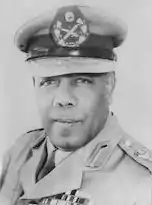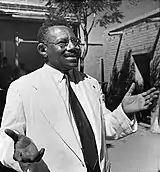List of heads of state of Sudan
This article lists the heads of state of Sudan since the country's independence in 1956.
| President of the Republic of the Sudan
رئيس جمهورية السودان | |
|---|---|
 | |
| Residence | Republican Palace Khartoum, Sudan |
| Term length | 39 months[1] |
| Formation | 17 November 1958 21 August 2019 (under the current constitution and in current form) |
| First holder | Five-member Sovereignty Council (collective presidency) |
| Salary | 29,320 USD annually[2] |
| Website | www |
 |
|---|
| This article is part of a series on the politics and government of Sudan |
|
|
History of the office
Since independence was proclaimed on 1 January 1956, six individuals (and three multi-member sovereignty councils) have served as head of state of Sudan, currently under the title President of the Republic of the Sudan. Prior to independence, Sudan was governed as a condominium by Egypt and the United Kingdom, under the name Anglo-Egyptian Sudan. As such, executive power was vested in a dyarchy consisting of both countries' heads of state – at the time of independence, the Queen of the United Kingdom (Elizabeth II) and the Egyptian Revolutionary Command Council (headed by Gamal Abdel Nasser). Immediately following independence, the role of head of state was filled by a five-member Sovereignty Council, with rival nationalist factions unable to agree on a single candidate. In November 1958, General Ibrahim Abboud led a military coup d'état, assuming the role of head of state as Chairman of the Supreme Council. Assuming the title of president in 1964, he resigned later that year due to general discontent around the rule of the military regime. Abboud was succeeded by a senior civil servant, Sirr Al-Khatim Al-Khalifa, who served as acting president for 18 days before transferring executive authority to a Committee of Sovereignty.
Ismail al-Azhari, the leader of the National Unionist Party, was made president in July 1965, and ruled with limited power until he was deposed in 1969. The military officers responsible for the coup established the National Revolutionary Command Council, chaired by Jaafar Nimeiry. Nimeiry, the leader of the newly formed Sudanese Socialist Union, assumed the position of president in 1971, and subsequently established a one-party state, which existed until 1985, when a group of military officers overthrew his government and established the 1985 Transitional Military Council, led by Field Marshal Abdel Rahman Swar al-Dahab. Ahmed al-Mirghani succeeded to the relatively powerless position of Chairman of the Supreme Council in 1986, after multi-party election held that year. He was deposed in a 1989 military coup led by Lieutenant-General Omar al-Bashir. Al-Bashir served as head of state, under the title of Chairman of the Revolutionary Command Council for National Salvation from 1989 to 1993 and as president from 1993 to 2019 (and from 1996 as the leader of the National Congress Party). Al-Bashir was removed from power by the Sudanese Armed Forces on 11 April 2019, amid ongoing protests after holding the office for nearly 30 years. Lieutenant-General Ahmed Awad Ibn Auf took control of Sudan without becoming head of state, established the 2019 Transitional Military Council, but resigned the following day in favor of Lieutenant-General Abdel Fattah al-Burhan.[3]
Titles of heads of state
- 1956–1958: Sovereignty Council
- 1958–1964: Chairman of the Supreme Council
- 1964: President
- 1964–1965: Committees of Sovereignty
- 1965–1969: Chairman of the Sovereignty Council
- 1969–1971: Chairman of the National Revolutionary Command Council
- 1971–1985: President
- 1985: Commander-in-Chief
- 1985–1986: Chairman of the Transitional Military Council
- 1986–1989: Chairman of the Supreme Council
- 1989–1993: Chairman of the Revolutionary Command Council for National Salvation
- 1993–2019: President
- 2019: Chairman of the Transitional Military Council
- 2019–present: Sovereignty Council
Heads of State of Sudan (1956–present)
(Dates in italics indicate de facto continuation of office)
Republic of the Sudan (1956–1969) | |||||||
|---|---|---|---|---|---|---|---|
| No. | Portrait | Name (Birth–Death) |
Elected | Term of office | Political party | ||
| Took office | Left office | Time in office | |||||
| 1 | .svg.png.webp) |
Sovereignty Council[lower-alpha 1] | — | 1 January 1956 | 17 November 1958 | 2 years, 320 days | Multipartisan |
| 2 |  |
Ibrahim Abboud (1900–1983) |
— | 17 November 1958 | 16 November 1964[lower-alpha 2] | 5 years, 365 days | Military |
| — |  |
Sirr Al-Khatim Al-Khalifa (1919–2006) Acting President |
— | 16 November 1964 | 3 December 1964 | 17 days | National Umma Party |
| 3 | .svg.png.webp) |
First Committee of Sovereignty[lower-alpha 3] | — | 3 December 1964 | 10 June 1965 | 189 days | Multipartisan |
| 4 | .svg.png.webp) |
Second Committee of Sovereignty[lower-alpha 4] | — | 10 June 1965 | 8 July 1965 | 28 days | Multipartisan |
| 5 |  |
Ismail al-Azhari (1900–1969) |
— | 8 July 1965 | 25 May 1969[lower-alpha 5] | 3 years, 321 days | Democratic Unionist Party |
Democratic Republic of the Sudan (1969–1985) | |||||||
| 6 |  |
Jaafar Nimeiry (1930–2009) |
1971[lower-alpha 6] 1977 1983 |
25 May 1969 | 6 April 1985[lower-alpha 7] | 15 years, 316 days | Military / Sudanese Socialist Union |
| 7 |  |
Abdel Rahman Swar al-Dahab (1934–2018) |
— | 6 April 1985 | 10 October 1985[4] | 187 days | Military |
Republic of the Sudan (1985–present) | |||||||
| (7) |  |
Abdel Rahman Swar al-Dahab (1934–2018) |
— | 10 October 1985[4] | 6 May 1986 | 208 days | Military |
| 8 |  |
Ahmed al-Mirghani (1941–2008) |
— | 6 May 1986 | 30 June 1989[lower-alpha 8] | 3 years, 55 days | Democratic Unionist Party |
| 9 |  |
Omar al-Bashir (born 1944) |
1996 2000 2010 2015 |
30 June 1989 | 11 April 2019[lower-alpha 9] | 29 years, 285 days | Military / National Congress Party |
| 10 |  |
Ahmed Awad Ibn Auf (born 1957) |
— | 11 April 2019 | 12 April 2019 | 1 day | Military / National Congress Party |
| 11 | .jpg.webp) |
Abdel Fattah al-Burhan (born 1960) |
— | 12 April 2019 | 20 August 2019 | 130 days | Military |
| 12 |  |
Sovereignty Council [lower-alpha 10] |
— | 20 August 2019 | Incumbent | 1 year, 165 days | Multipartisan (FFC and TMC) |
Latest election
| Candidate | Party | Votes | % | |
|---|---|---|---|---|
| Omar al-Bashir | National Congress | 5,252,478 | 94.05 | |
| Fadl el-Sayed Shuiab | Federal Truth Party | 79,779 | 1.43 | |
| Fatima Abdel Mahmoud | Sudanese Socialist Democratic Union | 47,653 | 0.85 | |
| Mohamed Elhassan Mohamed | National Reform Party | 42,399 | 0.76 | |
| Abdul Mahmoud Abdul Jabar Rahamtalla | Union of the Nation's Forces | 41,134 | 0.74 | |
| Hamdi Hassan Ahmed | Independent | 18,043 | 0.32 | |
| Mohamed Ahmed Abdul Gadir Al Arbab | Independent | 16,966 | 0.30 | |
| Yasser Yahiya Salih Abdul Gadir | Independent | 16,609 | 0.30 | |
| Khairi Bakhit | Independent | 11,852 | 0.21 | |
| Adel Dafalla Jabir | Independent | 9,435 | 0.17 | |
| Mohamed Awad Al Barow | Independent | 9,388 | 0.17 | |
| Asad Al Nil Adel Yassin Al Saafi | Independent | 9,359 | 0.17 | |
| Alam Al Huda Ahmed Osman Mohamed Ali | Independent | 8,133 | 0.15 | |
| Ahmed Al Radhi Jadalla Salem | Independent | 7,751 | 0.14 | |
| Isaam Al Ghali Tajj Eddin Ali | Independent | 7,587 | 0.14 | |
| Omar Awad Al Karim Hussein Ali | Independent | 6,297 | 0.11 | |
| Invalid/blank votes | 506,549 | – | ||
| Total | 6,091,412 | 100 | ||
| Registered voters/turnout | 13,126,989 | 46.40 | ||
| Source: NEC | ||||
Notes
- Members: Abdel Fattah Muhammad al-Maghrabi, Muhammad Ahmad Yasin, Ahmad Muhammad Salih, Muhammad Othman al-Dardiri and Siricio Iro Wani.
- Resigned after mass protests.
- Members: Abdel Halim Muhammad, Tijani al-Mahi, Mubarak Shaddad, Ibrahim Yusuf Sulayman and Luigi Adwok Bong Gicomeho.
- Members: Ismail al-Azhari, Abdullah al-Fadil al-Mahdi, Luigi Adwok Bong Gicomeho, Abdel Halim Muhammad and Khidr Hamad.
- Deposed in the 1969 coup d'état.
- Presidency referendum.
- Briefly interrupted during the 19–22 July 1971 coup d'état. Deposed in the 1985 coup d'état.
- Deposed in the 1989 coup d'état.
- Deposed in the 2019 coup d'état.
- Members:[5] Chairman Abdel Fattah al-Burhan, Mohamed Hamdan Dagalo, Yasser al-Atta, Shams al-Din Khabbashi, Salah Abdel Khaliq, Aisha Musa el-Said, Siddiq Tawer, Mohamed al-Faki, Hassan Sheikh Idris, Mohammed Hassan al-Ta'ishi[6] and Raja Nicola.
See also
References
- "Sudan: Civilian-majority ruling council sworn in". Deutsche Welle. 21 August 2019. Retrieved 24 August 2019.
- "The highest and lowest paid African presidents - Business Daily". Business Daily.
- El Sirgany, Sarah; Elbagir, Nima; Abdullah, Yasir (11 April 2019). "Sudan's President Bashir forced out in military coup". cnn.com. CNN. Retrieved 12 April 2019.
- "Sudan opposition coalition appoints five civilian members of sovereign council". Thomson Reuters. 2019-08-18. Archived from the original on 2019-08-18. Retrieved 2019-08-18.
- "FFC finally agree on nominees for Sudan's Sovereign Council". Sudan Tribune. 2019-08-20. Archived from the original on 2019-08-20. Retrieved 2019-08-20.